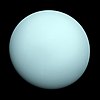아리엘 (위성)
| 아리엘 Ariel | ||
 보이저 2호가 관측한 아리엘 | ||
| 발견 | ||
|---|---|---|
| 발견자 | 윌리엄 라셀 | |
| 발견일 | 1851년 10월 24일 | |
| 명칭 | ||
| 다른 이름 | Uranus I | |
| 궤도 성질 | ||
| 모행성 | 천왕성 | |
| 궤도 긴반지름(a) | 191020 km | |
| 공전 주기(P) | 2.520 일 | |
| 평균 공전 속도 | 5.51 km/s[a] | |
| 궤도 경사(i) | 0.260° (천왕성 적도 기준) | |
| 궤도 이심률(e) | 0.0012 | |
| 물리적 성질 | ||
| 반지름 | 578.9±0.6 km[1] | |
| 표면적 | 4211300 km2 | |
| 부피 | 812600000 km3 | |
| 평균 밀도 | 1.592±0.15 g/cm3[2] | |
| 질량 | (1.353±0.120)×1021 kg[3] | |
| 표면 중력 | 0.269 m/s2 | |
| 탈출 속도 | 0.559 km/s | |
| 반사율 |
| |
| 자전 주기 | 동주기 자전 | |
| 겉보기등급 | 14.4 (R-밴드)[5] | |
| 최저 온도 | ? | |
| 평균 온도 | ≈ 60 K[6][7] | |
| 최고 온도 | 84 ± 1 K | |
아리엘(Ariel)은 천왕성의 제1위성이며 천왕성의 5개 주요위성 중 하나이다. 1851년 10월 윌리엄 라셀이 발견했지만, 러시아 태생의 천문학자 오토 슈트루베가 이보다 4년 먼저 발견한 것을 보인다.
아리엘은 천왕성 중심에서 19만 1,020 km 떨어진 거리에서 공전하고 있으며, 그 주기는 약 2.5일이다. 아리엘의 지름은 약 1158 km, 질량은 천왕성 질량의 약 1.8×10-5배이며 광도는 13.7등급이다. 아리엘은 다른 4위성과 같이 천왕성의 적도면과 같은 궤도면상을 공전하고 있다. 아리엘은 태양계에서 14번째로 큰 위성이다.
아리엘은 주로 얼음으로 이루어져 있으며, 약간의 얼어붙은 메탄과 암석이 섞여 있을 것으로 생각된다. 1986년 미국의 탐사선 보이저 2호가 보내온 사진은 아리엘의 표면이 낭떠러지와 긴 계곡 같은 지형으로 엇갈려 있음을 보여준다. 이들 중 몇몇은 지각운동으로 만들어진 듯한 물질이 부분적으로 채워져 있다. 몇몇 경우에는 얼음이 지구의 빙하흐름과 같이 계곡에서 뻗어나와 넓은 평원을 가로지르는 것처럼 보인다.
같이 보기
각주
- 내용주
- ↑ 다른 매개변수를 기준으로 계산했다.
- 참조주
- ↑ Thomas, P. C. (1988). “Radii, shapes, and topography of the satellites of Uranus from limb coordinates”. 《Icarus》 73 (3): 427–441. Bibcode:1988Icar...73..427T. doi:10.1016/0019-1035(88)90054-1.
- ↑ “Ariel: Facts and Figures”. NASA Solar System Exploration. 2014. 2014년 11월 29일에 원본 문서에서 보존된 문서. 2014년 11월 13일에 확인함.
- ↑ Jacobson, R. A.; Campbell, J. K.; Taylor, A. H.; Synnott, S. P. (June 1992). “The masses of Uranus and its major satellites from Voyager tracking data and earth-based Uranian satellite data”. 《The Astronomical Journal》 103 (6): 2068–2078. Bibcode:1992AJ....103.2068J. doi:10.1086/116211.
- ↑ Karkoschka, Erich (2001). “Comprehensive Photometry of the Rings and 16 Satellites of Uranus with the Hubble Space Telescope”. 《Icarus》 151 (1): 51–68. Bibcode:2001Icar..151...51K. doi:10.1006/icar.2001.6596.
- ↑ Arlot, J.; Sicardy, B. (2008). “Predictions and observations of events and configurations occurring during the Uranian equinox” (pdf). 《Planetary and Space Science》 56 (14): 1778–1784. Bibcode:2008P&SS...56.1778A. doi:10.1016/j.pss.2008.02.034.
- ↑ Grundy, W. M.; Young, L. A.; Spencer, J. R.; Johnson, R. E.; Young, E. F.; Buie, M. W. (October 2006). “Distributions of H2O and CO2 ices on Ariel, Umbriel, Titania, and Oberon from IRTF/SpeX observations”. 《Icarus》 184 (2): 543–555. arXiv:0704.1525. Bibcode:2006Icar..184..543G. doi:10.1016/j.icarus.2006.04.016.
- ↑ Hanel, R.; Conrath, B.; Flasar, F. M.; Kunde, V.; Maguire, W.; Pearl, J.; Pirraglia, J.; Samuelson, R.; Cruikshank, D. (1986년 7월 4일). “Infrared Observations of the Uranian System”. 《Science》 233 (4759): 70–74. Bibcode:1986Sci...233...70H. doi:10.1126/science.233.4759.70. PMID 17812891.
외부 링크
- Ariel profile at NASA's Solar System Exploration site
- AN, 33 (1852) 257/258
- Ariel basemap derived from Voyager images
- Ariel page (including labelled maps of Ariel) at Views of the Solar System
- NASA archive of publicly released Ariel images
- Paul Schenk's 3D images and flyover videos of Ariel and other outer solar system satellites
- Ariel nomenclature from the USGS Planetary Nomenclature web site
- Ted Stryk: Revealing the night sides of Uranus' moons


